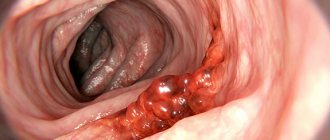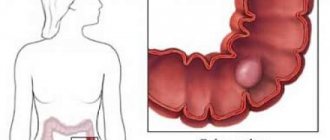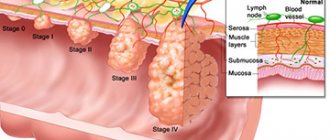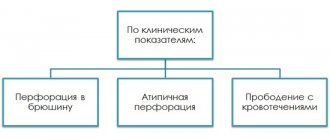Colon cancer is one of the most common pathologies of the gastrointestinal tract, ranking 3rd in global clinical practice. In the Russian Federation, it is more common in men. As a percentage, the disease among Russian males is 5.3%. For women, this figure is 4.7%. Oncologists try to preserve the functions of this organ by performing surgery. This is largely determined not only by the use of the latest operating techniques, but by a properly conducted rehabilitation period. The choice of the only correct restorative technique and diet for such a patient is largely determined by the condition after removal of the intestinal tumor. This operation is one of the most traumatic types of surgical intervention. In addition, most often it has to be performed on elderly patients who have difficulty recovering after tumor removal due to the presence of concomitant diseases of systemic organs, which increase the risk of postoperative complications.
Diagnostic specifics
Cancer affects the intestine in different segments. The higher the tumor is localized in the rectum, the greater the risk of metastases that penetrate into the nearest lymph nodes.
The degree of malignant lesion is determined differentially: the higher its value, the greater the danger the patient is exposed to. Oncologists have developed the following gradation for this neoplasm :
- high, in which more than 95% of cancer cells are glandular tissue;
- moderate, for which the level of glandular structures is 50-95% in cells affected by cancer;
- low, in which neoplasms are occupied by extracellular mucus, ranging from 5 to 50% or higher;
- undifferentiated, in which no more than 5% of mutated cells are detected during diagnosis.
The degree of development of the oncological tumor will determine the condition after removal of the intestinal tumor.
To determine the stage of the disease and choose effective treatment tactics, doctors use different diagnostics:
- taking anamnesis;
- study of analyses;
- colonoscopy;
- MRI;
- Ultrasound;
- computed tomography of the peritoneum;
- X-ray;
- clinical and biochemical blood test;
- ECG.
Doctors also usually prescribe for older people who seek help an additional examination of blood coagulation, ultrasound diagnostics of the blood vessels of the cervical spine, legs, echocardiography, and also suggest examination by a cardiologist, neurologist and endocrinologist in cases where they have a number of chronic systemic pathologies organs.
The success of treatment directly depends on the quality and efficiency of diagnostic measures. Modern hardware examination of patients allows early detection of intestinal cancer in a patient with a high degree of probability. This ensures successful treatment. During the examination, ultrasound machines, MRI, colonoscopy and other examination techniques are used to accurately determine not only the presence of a malignant tumor in the intestine, but also its location.
Comprehensive diagnostics is especially effective in the early stages. The problem of oncology treatment is early diagnosis. Modern techniques make it possible to successfully treat the disease in the early stages, while maintaining patients’ usual lifestyle. Clinical practice statistics in developed countries show good results. In Japan, specialists were able to significantly reduce the mortality rate among people with this form of cancer.
A biochemical analysis of blood and urine is also performed. With their help, various substances are identified that leave cancer cells in the body:
- enzyme;
- proteins;
- hormones;
- antigens.
Cancer, like infection, causes the development of inflammatory processes in the body. An in-depth analysis of blood and biological fluids allows you to accurately determine the cause of inflammation and malaise. Such analyzes are carried out within one day. Having received them and the results of the hardware examination, the oncologist has the opportunity to obtain accurate information about the condition of the cancer patient at the stage of selecting a treatment system for the disease.
One type of analysis is not enough to make a diagnosis and prescribe a specific treatment. When taking blood, specialists examine the sedimentation rate of erythrocytes, leukocytes and hemoglobin. If there are deviations from the norms typical for a healthy person and the results of hardware diagnostics, an oncological disease is detected. Doctors always accurately determine the cause of the inflammatory process in the body.
Patients with cancer have an increased content of leukocytes in the blood, which in medicine is called leukocytosis. Against this background, ESR increases and hemoglobin levels sharply decrease. This result of a biochemical and clinical blood test does not always indicate the presence of cancer in a person. Such blood composition indicators are caused by any inflammation in the body.
Loss of hemoglobin can result from poor nutrition or extensive blood loss. When the intestine is damaged by cancer, hemoglobin also drops significantly at an early stage of its development. This is due to the fact that the specific structure of cancer cells does not allow it to be produced in the required volume due to changes in the condition of the blood. Because of this, the amount of oxygen in the blood decreases because hemoglobin cannot deliver it to healthy cells. If, after repeated biochemical analysis, a patient has low hemoglobin over a long period of time, it is necessary to undergo an in-depth diagnostic examination to identify the causes of this process.
Detection of intestinal tumors in the early stages significantly simplifies treatment and reduces the risk of postoperative complications.
Histological types of malignant intestinal tumors
Cancers are characterized by partial or complete loss of differentiation. Mutation processes lead to the fact that tumor cells differ from healthy cells. Tumors are presented in different histological forms, so in medicine for a long time there was no standardized histological classification.
Today, oncologists distinguish pathologies using a unified international histological classification of intestinal tumors. According to this classification, tumors are divided into epithelial and non-epithelial.
The main types of intestinal tumors related to oncological pathologies:
- adenocarcinomas;
- mucinous adenocarcinomas;
- signet ring cell carcinoma;
- squamous cell carcinoma.
Intestinal adenocarcinoma
Adenocarcinoma is the most common type of malignant intestinal tumor and is diagnosed in 80-85% of patients. Adenocarcinoma has different degrees of malignancy (differentiation).
Depending on the degree of differentiation, the following types of adenocarcinomas are distinguished:
- highly differentiated - the formations include different cellular structures that have certain similarities with normal intestinal cells;
- poorly differentiated - the structure of the tumor includes only undeveloped aggressive cells;
- moderately differentiated - formations contain highly differentiated and poorly differentiated elements.
Modern treatment of intestinal cancer in Israel makes it possible to achieve good results in the fight against adenocarcinomas using surgical methods, radiation therapy, chemotherapy, and targeted therapy. If the tumor is detected early, the prognosis will be encouraging. In most cases, complete recovery occurs.
Mucous adenocarcinoma
In terms of prevalence, this type of tumor ranks second after adenocarcinoma and occurs in approximately 15% of patients. The structure of mucous adenocarcinoma is made up of glandular cells that are capable of producing large amounts of mucus. Oncologists speak about the diagnosis of mucinous adenocarcinoma if the patient has more than 50% of cells producing mucus.
This type of tumor responds less well to treatment compared to adenocarcinoma. Combination therapy is used to treat pathology.
Signet ring cell carcinoma
Tumors of this type are diagnosed in 3-5% of patients. Signet ring cell tumors consist of cells that are located in isolation and contain a lot of cytoplasm, due to which the cell nucleus is shifted to the edge. The tumor formation does not have clearly defined boundaries; it adheres to adjacent tissues.
This cancer is typical for young men under 40 years of age. The tumor grows rapidly, is characterized by an aggressive course and a high tendency to metastasize. For cancer treatment in Israel to be successful, this type of tumor must be diagnosed as early as possible.
Squamous cell colon cancer
Tumors of the squamous cell type are diagnosed in no more than 2% of patients. The most common localization of pathology is the preanal area. The cells included in the structure of the formation are not keratinized and have a squamous cell structure. Squamous cell tumors do not respond well to chemotherapy treatment, so the treatment program includes surgery and radiation treatment.
Features of treatment of colon affected by cancer
When diagnosing a malignant neoplasm in the intestine, it is classified according to a certain scheme:
- by location on the intestine;
- size of the lesion;
- form;
- affected area;
- histological structure;
- by whether the lymph nodes are affected by it or not;
- the presence of metastases.
Oncological tumors have only four stages of development. At the beginning, it is easier for a specialist to select an effective treatment than at the final stages of the pathology. When choosing the appropriate method, the oncologist always proceeds from the presence of contraindications in the patient to a particular technique. In this case, most often the doctor uses surgery to combat such oncology. This technique can be complemented by chemotherapy. The operation itself can be not only open, but also minimally invasive. The type of complex treatment will directly determine what the condition will be after removal of an intestinal tumor. After any operation, the patient requires rehabilitation. The difficulty is that patients often seek medical help in the last stages of oncology.
Treatment of colon cancer
Operation
The most popular treatment method, both ten years ago and today. In 90 percent of cases, this operation is radical.
It can also be performed through an abdominal incision or laparoscopic (several incisions). If lymph nodes are affected, lymphadenectomy is used.
Chemotherapy
Using agents that inhibit the development of bad cells. As a result, the tumor becomes smaller, growth stops, and metastasis to other organs decreases.
Radiotherapy
Radiation aimed at combating diseased cells. Significantly reduces the tumor, destroys atypical cells after surgery, and prevents relapse.
Treatment with medications
Treatment with medications is especially necessary for the patient if he has already had surgery.
Treatment is always individualized.
The doctor chooses what and how to treat with medication based on the results of operations and tests, as well as national and international recommendations on this topic.
All drugs are prescription drugs and cannot be purchased just like that.
Prescription of medications after surgery is done to prevent further relapse. Chemotherapy procedures may be used along with this.
As adjuvant therapy, drugs such as Bendamustine, 5-fluorouracil, and capecitabine in tablet form are often used. If the situation requires it, Oxaliplatin may be prescribed.
Surgical treatment methods
This is the most common way to combat the disease and is considered the most effective. There are radical and supportive (palaitical) resections. In the first case, the tumor is removed from the intestine in those places where healthy soft tissue comes into contact with lymph nodes affected by cancer .
The supportive technique is used for inoperable patients. With its help, intoxication and pain are relieved, and the patient’s general condition is improved so that the last period of his life is as comfortable and long as possible.
Any type of treatment is aimed at saving a person's life. To achieve this goal, the period after surgery is important. At this time, the patient may be prescribed additional treatment in the form of chemotherapy. Continuation of therapy may also be required for chronic diseases of systemic organs. The choice of restorative and paleative therapy depends on what the patient’s condition is after removal of an intestinal tumor
Chemotherapy
This is a technique that kills cancer cells. Substances that are introduced into the human body are toxic, but they are the ones that cause the death of malignant cells. If a person has a strong immune system and a small focus of cancer, it is possible to achieve the complete destruction of cancer pathology in any organ, including the intestines.
These are strong drugs that often have strong side effects on important internal organs, primarily the liver and kidneys. In general, their effect on healthy organs is quite gentle; today this is the most common therapeutic technique in oncology.
However, when treating colon affected by cancer, chemotherapy is always used as part of a combination treatment. Surgery is always performed in this case, as it is the only way to save the patient’s life.
The doctor first looks to see if surgery can be performed. If this cannot be done immediately, then chemotherapy is prescribed, after which resection is performed. Then, depending on what the condition is after removal of the intestinal tumor , such treatment is prescribed or not prescribed.
The main side effect of chemotherapy is loss of nail plates and damage to hair follicles. Patients' hair falls out after chemotherapy. Also, side effects due to general intoxication may include nausea, vomiting, dizziness and loss of strength.
There are different types of drugs that are related to chemotherapy:
- anticancer antibiotics;
- hormonal drugs;
- immunosuppressants;
- alkaloids and other cytostatic drugs that are prescribed for intestinal oncology at all stages of the tumor in combination treatment and as independent therapy after surgery.
Chemotherapy may be given before surgery to shrink the tumor and stop its growth, and may also be given after surgery. Often, the use of such drugs is combined with radiation exposure, which results in effective treatment and a favorable prognosis. The use of combined or simple treatment methods will determine what the condition will be after removal of an intestinal tumor.
Causes of colon tumor
Scientists around the world have been analyzing for many years what the true causes of colon tumors are.
Such long-term studies have made it possible to identify the most significant etiological factors leading to the development of this oncopathology:
- Hereditary predisposition to the development of the disease. In particular, familial polyposis, which is a genetically determined disease. This pathology always leads to people developing a colon tumor at one age or another.
- Another genetic disease that provokes the development of a tumor is Lynch syndrome. In this case, most often the tumor develops in older people and is found in the right colon.
- Improper nutrition with a high content of animal proteins, fats, and refined carbohydrates in food against the background of a low content of plant fiber contributes to the development of the tumor.
- Additional risk factors are: low physical activity, excess body weight and metabolic disorders.
- The risk of developing a malignant neoplasm increases due to prolonged constipation and other chronic intestinal diseases. These are various colitis, intestinal diverticula, villous and adenomatous polyps.
- Various chemicals that enter the body have a carcinogenic effect. These are aromatic amines, hydrocarbons, steroid hormones, etc.
- Bad habits, such as alcohol abuse and smoking, have a negative effect on the intestinal walls, provoking the development of tumors.
Preparing for surgery
Before each intestinal resection, the patient must undergo special preparation. This is a special organ that requires preliminary cleaning before surgery. A large number of microflora live in it, including pathogenic ones. Only in emergency cases, a limited amount of preparatory measures are carried out.
Due to preparation, it is possible to avoid sepsis and infectious complications . The intestines contain a lot of microflora, including pathogenic ones. You need to get rid of it before removing the tumor.
The intestines must be cleaned with liquids, enemas and special diets. Before the operation itself, food intake is stopped 12 hours. Later, the amount of fluid is limited. Before removal, the patient is prescribed antibiotics for complete sanitation of the peritoneum and rectum.
If the patient is taking anti-inflammatory drugs, the doctor should be told about this. You should stop taking such drugs before surgery, as they can cause bleeding. The specialist explains to the patient the reason for withdrawal and tells what the condition may be after removal of an intestinal tumor if you do not stop taking non-steroidal medications, including aspirin.
Indications for intestinal surgery are:
- benign and malignant neoplasms;
- gangrene;
- obstruction;
- adhesions;
- developmental anomalies of this organ;
- diverticulitis;
- volvulus.
Resection is not performed if there are:
- high risk of surgical intervention;
- terminal states when a person dies;
- coma;
- advanced cancer with metastases.
Doctors always begin operating on the intestines when they detect a tumor and mesenteric thrombosis in a patient . In the first case, the operation is not performed urgently. When the intestines are affected by cancer , the patient is first prepared for surgery, which may include chemotherapy and radiation as a complex treatment. Surgery can be performed in this case only after a certain period after diagnosis.
In case of thrombosis, immediate resection is performed, because ischemia and necrosis of the intestinal wall cause severe intoxication. Without surgical intervention, in this case, peritonitis may develop, followed by the death of the patient as a result of general blood poisoning. In this case, there is no time for preparation and diagnostics.
Features of surgical methods
Treatment of patients with cancer is carried out using surgery. In the early stages of the pathology, when its size does not exceed 30% of the circumference of the intestine, doctors remove a small affected part of the organ, trying to preserve its functionality as much as possible.
When the pathology affects the intestine in the middle or lower sections, complete resection is most often performed. In this case, the patient is deprived of a natural opening through which emptying occurs. The surgeon takes part of the colon out to drain the intestine. As a result, the patient experiences a change in his usual style and quality of life. He is prescribed a special regimen that he will have to adhere to for the rest of his life:
- strict diet;
- using the bone as an anus;
- the colon performs the functions of accumulating and retaining feces, which were previously performed by the rectum.
Surgical intervention can be performed using laparoscopy with minimal trauma in the form of a puncture of the peritoneum, or in the form of open access through an incision in the abdominal cavity. The choice of surgical technique also directly determines the condition after removal of an intestinal tumor.
If the cancer is stage 2-3, chemotherapy options are used. If the tumor has become motionless and has grown into neighboring organs and tissues, then its removal is impossible. First, the patient needs to undergo radiation and chemical therapy. the tumor can be removed surgically. If surgery is not possible, palliative therapy is prescribed and radiation therapy is continued. The use of chemotherapy continues for a certain period of time, since long-term use of drugs can completely damage blood vessels, liver and kidneys.
After removal, during the recovery period, doctors try to bring the metabolism back to normal in order to avoid exhaustion of the body, weakened by cancer and treatment, from a lack of nutrients.
After surgery, which is always dangerous, the patient often experiences various complications:
- pain;
- bleeding;
- the formation of a hole in the wall of the colon;
- intestinal obstruction.
The characteristics of complications also directly determine what the condition will be after removal of an intestinal tumor. The doctor observes such a patient continuously for 2 years. Then examinations are carried out once a year, sending the patient for a comprehensive diagnosis.
Treatment methods for bowel cancer
A patient diagnosed with colorectal cancer is treated by a team of specialist doctors. It may include: oncologist, surgical oncologist, chemotherapist, radiation diagnostics doctor, gastroenterologist, psycho-oncologist. The choice of treatment tactics is carried out taking into account several factors:
- Stage and type of cancer.
- Location of the tumor in the intestine.
- Age, health status of the patient.
- Concomitant diseases, complications caused by the tumor.
Surgical treatment of bowel cancer
Surgery is the main, most radical method of treating colon cancer. If the tumor is caught at an early stage, it can be removed along with some of the surrounding tissue. The sample is sent to the laboratory, where pathologists examine the appearance of the cells and the resection margin under a microscope. If the resection margin contains tumor cells, or it is found that the cells are poorly differentiated and have almost completely lost their normal features, the doctor may prescribe a repeat operation. Part of the intestine that may contain tumor cells is removed to help prevent recurrence.
Often you have to perform a resection ( colectomy ) - remove part of the intestine containing the tumor. The remaining parts of the intestine are connected - an anastomosis . Sometimes it is not possible to perform an anastomosis right away. In such cases, a colostomy or ileostomy : the end of the colon or ileum is brought to the surface of the skin, respectively. Feces will temporarily pass through the formed hole. After some time, a second operation is performed: the colostomy or ileostomy is closed, the ends of the intestine are connected.
In cases where radical surgery is impossible and the tumor blocks the intestinal lumen, palliative interventions are resorted to. Their goal is to ensure normal passage of stool and improve the patient’s condition:
- Intestinal stenting . A stent is installed into the intestinal lumen - a hollow cylindrical frame with a mesh wall.
- Permanent colostomy . If the lower part of the colon is blocked by a tumor, a colostomy is brought to the surface of the skin to pass stool.
Chemotherapy for colon cancer
Chemotherapy for colorectal cancer comes in different types:
- Adjuvant : after surgical treatment, to prevent relapse.
- Neoadjuvant : given before surgery. Helps reduce the size of the tumor, simplify its removal, convert inoperable cancer into operable cancer, and reduce the risk of relapse after surgery.
- Palliative : prescribed as an independent, main method of treatment, in late stages, when radical surgical treatment is impossible. This chemotherapy helps improve the patient’s condition, reduce symptoms, and increase life expectancy.
For colon cancer, chemotherapy drugs such as capecitabine, 5-fluorouracil, oxaliplatin, and irinotecan are used. As a rule, treatment is carried out with a combination of 2-3 drugs.
Targeted therapy
In recent decades, much has become known about the processes that occur in malignant tumors at the molecular level. Scientists have identified many genes whose mutations are responsible for causing cancer. Molecules are known that allow cancer cells to survive and multiply uncontrollably. Drugs have been created that can block these molecules - they are called targeted drugs .
Three groups of targeted drugs are effective for colon cancer:
- VEGF blockers are substances that cancer cells produce to stimulate the growth of blood vessels and provide themselves with oxygen and nutrients. This group includes drugs: bevacizumab, ramucirumab, ziv-aflibercept.
- Blockers of EGFR, a receptor protein that is present in large quantities on the surface of cancer cells and, when activated, stimulates their growth. This group of drugs includes: cetuximab, panitumumab.
- Inhibitors of kinases - signaling enzyme proteins. Regorafenib belongs to this group.
Targeted drugs are used for colorectal cancer in advanced stages.
Immunotherapy
Immunotherapy is another modern direction in the treatment of malignant tumors. It uses the resources of the immune system to fight cancer cells.
Normally, the immune system is constantly forced to restrain itself: if immune cells behave too aggressively, serious autoimmune conditions can develop. checkpoints as a “brake pedal . Cancer cells know how to use checkpoints to their advantage. They block the activation of immune cells and thus protect themselves from their aggression.
Currently, there is a special class of immunotherapy drugs - checkpoint inhibitors . They reactivate the immune system, causing it to attack the tumor tissue.
For colorectal cancer, drugs from the group of checkpoint inhibitors are used: nivolumab (Opdivo) and pembrolizumab (Keytruda).
Radiation therapy for colon cancer
Radiation therapy, like chemotherapy, for colon cancer is used before, after surgery, and for palliative purposes in late stages. In addition, irradiation of the tumor can be performed directly during surgery.
Sometimes radiation therapy is prescribed in combination with chemotherapy - this is the so-called chemoradiotherapy. It is highly effective, but is accompanied by more serious side effects.
Benefits of laparoscopy
Colon surgery can be performed using laparoscopy. This is an operation in which the surgeon creates several puncture holes for the introduction of special instruments. After it, the patient recovers faster because he loses less blood. The type of operation chosen directly determines the condition after removal of an intestinal tumor.
But in some cases it is not technically feasible; sometimes for some patients it is safer to use an open technique.
During laparoscopy, instruments are inserted into the abdomen through punctures, and carbon dioxide is injected to improve visibility. After this, having discovered a tumor, the surgeon clamps the intestine above and below the location of the pathology, suturing the mesenteric vessels and removing the intestine affected by cancer.
In what cases is open surgery performed?
This method is most often chosen due to the risk of gangrene and extensive blood poisoning. Necrotic lesions result from atherosclerosis of the arteries in the peritoneum. It is necessary to remove such pathology using laparotomy in cases where it is large, or it is technically impossible to perform a closed operation.
With this method, the surgeon cuts the peritoneal wall into several centimeters. Laparotomy has a number of advantages:
- a good overview of the organs is created for more precise manipulations with them;
- high precision of manipulation, allowing removal of the organ within healthy tissue to prevent recurrent tumor formation;
- the possibility of performing it in any hospital, since most oncologist surgeons are fluent in laparotomy.
When performing laparotomy on a tumor-affected intestine, the surgeon needs to remove the damaged area of the organ as carefully as possible so as not to provoke the development of necrosis again. This is one of the main factors influencing the condition after removal of an intestinal tumor. If there is a tumor in the intestine, a colostomy is created to remove feces, which can remain forever, or after a few months it is removed to restore continuous bowel movement. This is a complex medical procedure performed under general anesthesia over several hours.
To reduce the risk of infection of nearby tissues with intestinal contents during surgery, nurses isolate them with napkins and tampons. It is practiced to change tools when moving from a more “dirty” stage to the next one.
The operation to remove the tumor is completed by washing the abdominal cavity, layer-by-layer suturing of the abdominal tissue and installing drainage tubes for the outflow of discharge.
Alternative and Complementary Treatments at Home
Alternative approaches offer many different options for the treatment of colon cancer, but conditionally all of them can be divided into two groups:
- antitumor recipes (folk remedies);
- taking immunostimulants.
Folk remedies
Traditional methods of treatment for the first group of tumors, as a rule, contain poisonous plants.
Here you need to be especially careful. Let's consider some popular recommendations from traditional medicine:
Vinca minor herbs have a good effect on cancer. An infusion is prepared from dry herbs, previously crushed, which is infused in a glass of boiling water for half an hour, and then taken one spoonful several times a day.
Colchicum herb is also a good remedy against tumors. One tablespoon of herb is brewed in 0.5 liters of boiling water and allowed to brew for half an hour. Then it is consumed orally, no more than a tablespoon at a time, two or three times a day, before meals. In just a few weeks, it will be possible to evaluate the positive dynamics.
Tibetan healers use an infusion of peony roots against tumors. The root is poured with a liter of water, infused under a lid for an hour and, after straining, consumed three times a day fifteen minutes before meals.
For patients with oncology, prepared tea with wild elderberry helps well; mainly the root part is used. It is especially recommended in the intervals between radical treatments. You need to take a couple of pinches of the raw material, brew it with a glass of hot water, like regular tea, and divide the tincture into two parts. One is drunk immediately, and the second is filtered and repeated after five hours.
Very red geranium roots are another remedy for various types of tumors. The herb in the amount of one tablespoon should be poured with 0.5 liters of boiling water and kept on fire for about fifteen minutes. Next, the broth needs to brew for about an hour. After straining, it is worth consuming 200 ml three times a day.
Aconite has long been used to treat many diseases of the body. Since ancient times, many healers have described that this folk remedy helps with cancer.
The maximum effect can be achieved by using aconite and a decoction of its tubers in conjunction with classical methods of treating tumors.
The plant is poisonous and should be used with caution after consulting a doctor.
The roots are neutralized and filled with fresh water (about three liters of water are taken per 50 grams of grass). Next, immerse in boiling water and keep on fire for about an hour. After this, you need to immerse the raw materials in clean fresh water for 1-2 days. Then they strain and steam the remaining slices for about 12 hours and dry.
To take a decoction prepared in this way, it is better to first consult a specialist. To treat tumors, take 1-2 drops and add it to tea and drink it twice a day.
Nutrition
Diet for detected oncological diseases affecting the intestines should contain a lot of plant fiber, since it has a cleansing effect, fights constipation, and accelerates the elimination of toxins.
If a person is diagnosed with colorectal cancer, foods high in fat and protein should be excluded from the diet. Preference should be given to foods rich in vitamins A, C, complex carbohydrates and plant fibers.
The necessary substances are found in vegetables, including potatoes, cabbage and tomatoes, as well as in grains such as brown rice, corn and wheat flakes. In some fruits - avocados, bananas, citrus fruits.
How the intestines are connected after removal of a cancerous tumor
After removing the tumor, you need to connect the ends of the intestine. If the ends cannot be connected, the patient has an outlet placed on the abdominal wall.
If it is possible to connect the ends of the intestine after surgery, they can be connected:
- end to end;
- side to side, when the opposite ends of the intestine are connected by their lateral surfaces;
- side to end. This is how sections of the intestine that differ in anatomical characteristics are connected.
Surgeons can, in some cases, create a temporary or permanent overlay of the outlet on the anterior wall of the abdomen. This also determines what the condition will be after removal of an intestinal tumor.
This connection is called a colostomy. With its help, feces will be removed from the intestines on a temporary or permanent basis.
Features of intestinal surgery
This surgery is different from operations on other parts. This is due to the peculiarities of the structure and location of the organ, firmly fixed in the pelvis and close to the organs of the genitourinary system, as well as the functional characteristics of the rectum, which removes feces from the body. The other part of the colon cannot perform this function.
Surgery on the rectum affected by cancer is technically more complex and produces more complications and unfavorable outcomes than removal of a tumor in the thin or thick section. This also affects the condition after removal of an intestinal tumor.
The difficulty of operating on the rectum is that the doctor seeks to preserve the natural opening for bowel movements. After removing the affected part of the intestine, he creates a connection that is as similar as possible to the anatomy of the anus. If you have to remove all the components of the anal canal, then you have to do plastic surgery of this segment of the intestine after removing its part affected by cancer.
Such surgical intervention, leading to the removal of the anus, is performed today in rare cases when there are no other ways to fight for the patient’s life. If malignant neoplasms have not penetrated into the nearby tissues of the anal sphincter, then the natural opening is preserved. Laparotomy on the rectum is always performed under general anesthesia. It always ends with the installation of drains in the pelvis. In this case, it is important for the doctor to know what the condition is after removal of an intestinal tumor in severe patients in order to choose supportive treatment and prolong their life.
What to do if you suspect a disease
General stool analysis (coprogram)
With a tumor accompanied by bleeding from the distal colon, the stool may have a pronounced red color. With disintegrating colon tumors, blood may be found in the stool. Pus on the surface of the stool occurs when there is severe inflammation and ulceration of the colon mucosa (disintegration of an intestinal tumor), often along with blood and mucus. When a colon tumor is in the stage of decay due to bleeding, the reaction to blood (Gregersen reaction) is positive.
Survival rate after tumor removal
For patients who have had a cancerous colon or rectum removed, survival after surgery directly depends on how quickly they seek medical help.
Survival is a medical indicator of the effectiveness of the chosen treatment technique in oncology. Prognosis always depends on the depth of tissue damage and the presence of metastases in the lymph nodes.
Those who begin treatment for colon cancer at an early stage live the longest after surgery. Oncologists predict a 5-year survival rate for them in 90% of patients.
Even in the presence of metastases in the lungs and liver, with timely chemotherapy and surgical treatment of the tumor, patients can gain an additional 5 years of life in 30-50%. On average, for patients who become ill for the first time, the prognosis for survival is one year for 46% and five years for 54%.
Rectal cancer is considered one of the most dangerous oncologies. Removal of a malignant neoplasm in any part of the intestine aims to preserve the patient’s life. After it, his usual life changes forever. A person will have to change his habits, hobbies, and adapt his entire life to the work of the body. To prevent the recurrence of a tumor, the patient must undergo regular examinations and follow the recommendations of doctors. All patients with this pathology need to know what the condition is after removal of an intestinal tumor in order to psychologically prepare for such changes.
Nutrition in the postoperative period for intestinal oncology should be therapeutic. It makes the digestion process more efficient, strengthening and gradually restoring the role of the intestines. Such patients eat by the hour, according to a certain diet, which helps to empty the body. The menu option is always agreed with the doctor.
What are the primary symptoms of colon cancer?
Symptoms of rectal cancer in the early stages are usually mild, periodic and may not cause concern to the patient.
The primary sign of the development of a malignant tumor in the intestine is the appearance of pathological discharge from the intestine (mucus and blood). At an early stage, streaks of blood can be seen in the stool. As the tumor grows, you may notice significantly more bleeding. At the same time, it darkens, even black, and is often excreted along with feces, but can also appear before defecation. The presence of a foul odor and blood clots are signs that the cancer has reached an advanced stage.
The secreted mucus usually contains bloody streaks or bloody discharge. When cancer is advanced, purulent-bloody fluid or pus that has a foul odor is secreted along with mucus.
Blood or blood with mucus in the stool should not be ignored. It is necessary to consult a specialist, undergo a digital examination and rectoscopy. Often these signs are accompanied by diseases such as hemorrhoids, chronic paraproctitis, the presence of anal fissures and other problems. And patients attribute the symptoms that appear to precisely such conditions. But we must not forget that it is quite possible to develop several diseases at once.
An increase in the size of the formation causes more pronounced signs of bowel cancer:
- discharge of blood in large quantities;
- the appearance of blood clots;
- feeling that there is a foreign body in the rectum;
- the stool becomes ribbon-like.
When the initial clinical picture appears, treatment of an intestinal tumor abroad allows you to completely remove the tumor with minimal trauma to the body.
What consequences may occur after removal of bowel cancer?
Cancer of the digestive system, according to modern statistics, ranks first among cancer diseases and the prognosis for such pathology is often unfavorable. Of course, the health and vital activity of the patient depends on the histological structure of the cancer tumor, its location, stage of formation, treatment and postoperative recovery of the patient.
Cancer can affect all organs of the gastrointestinal tract.
The most common type of abdominal cancer is stomach cancer, followed by the esophagus. The latter is distinguished by a severe form of malignant neoplasm with an unfavorable prognosis. With the first and second stages of esophageal cancer after surgical treatment, patients live for about three years. Such a tumor is usually removed by surgery; there are also cases of effective therapy with radiation and chemotherapy. Such treatment is carried out before and after removal, as well as as an independent treatment technique. The most favorable prognosis is observed after combination therapy for esophageal tumors, in which case people live up to five years.
Upper cancer is less common than rectal cancer. Most often, elderly people after fifty years of age suffer from this dangerous pathology. Among patients, a higher percentage falls on older men.
Even with modern technology and compliance with all measures, complications may arise during surgery on the intestine affected by cancer . Its contents contain a large volume of microorganisms that are a source of infection. The most common negative consequences after resection are:
- the appearance of pus in the suture area;
- bleeding;
- peritonitis;
- stenosis of a section of the intestine;
- dyspeptic disorders.
Often patients have a question about what happens after removal of an intestinal tumor. The doctor will describe in detail his individual condition before the operation and tell him about possible complications, which are always individual.
Recovery after surgery depends on the complexity of the operation and the general condition of the person, and his compliance with doctors’ recommendations. In addition to generally accepted measures, including proper hygiene of the postoperative wound, early activation, in such pathology the diet and diet of the patient play an important role.
Causes of tumors in the intestine
A predisposition to pathological degeneration of the cellular tissue of the intestinal mucosa can develop after exposure to carcinogenic substances that enter the human body along with food. They are found in fried foods, smoked products and synthetic additives, substitutes for natural taste, smell and color. All this negatively affects the digestive process, the functioning of the stomach and intestines. A monotonous and unbalanced diet, weight loss diets can also be a factor in the development of inflammatory processes in the intestines that degenerate into cancer. The cause of a malignant neoplasm can be constant poisoning with surrogate alcohol and drugs, as well as poisoning with drugs and poor-quality food.
Those people who work in hazardous industries are also at high risk. Constant exposure to carcinogens can lead to the development of cancer.
Intestinal cancer can develop with frequent congestion, constipation and slag deposits on the walls of the intestinal canals. Long-term constipation increases the risk by negatively affecting the intestinal wall. The cause of the development of oncology can be infectious diseases and inflammatory processes in different parts of the intestine such as stomach ulcers, gastritis and other pathologies of infectious etiology.
Cancer can affect the intestine as a result of the formation of postoperative scars, polyps and other pathological changes. You can get colon cancer if you have a genetic predisposition.
Secondary symptoms of bowel cancer
The appearance of secondary signs of cancer indicates that the formation has increased significantly. The clinical picture develops against the background of narrowing of the intestinal lumen and limited mobility of the intestinal walls.
When the upper intestine is affected, intestinal obstruction of varying severity develops, and complete obstruction is possible. First, the process of moving feces through the intestines is disrupted, which leads to bloating, constipation, and rumbling. If the disease is advanced, then spasmodic pain occurs in the abdominal area.
A characteristic symptom of this condition is the alternation of periodic diarrhea with persistent constipation. This happens due to a significant narrowing of the lumen of the rectum, through which dense feces do not pass. Against the background of this disorder, water absorption decreases, while secretory activity and intestinal motility increase.
Part of the feces is retained in the colon, in front of the tumor canal. If this condition is not eliminated in time, obstructive intestinal obstruction, end-to-end disruption of the intestinal wall above the tumor and fecal peritonitis develops. In such cases, cancer treatment abroad must be urgent.
If the ampullary part of the rectum is affected, then complete obstruction occurs very rarely, which is due to the wide lumen in this part of the intestine. More often, partial intestinal obstruction is diagnosed, while the patient has a feeling of incomplete emptying due to the fact that a tumor is developing in the intestine.
A tumor developing in the lower part of the rectum causes significant narrowing and painful, frequent urge to defecate, up to 15 times during the day. When trying to empty the intestines, a small amount of liquid feces is released from the rectum, which contains pathological impurities, or nothing is released at all. The presence of a tumor in the intestine is perceived by the body as a foreign body, and the defecation reflex is triggered, but solid feces do not pass through the areas of the intestine that are narrowed. The prognosis of intestinal cancer in this case will depend on how quickly and efficiently the treatment is completed. The prognosis is also affected by the presence of metastases, for example, if a patient is undergoing treatment for bone cancer abroad, then the prognosis of intestinal cancer takes into account the success of all treatment measures.
Recovery after removal of intestinal cancer
The recovery of a patient after surgery on the intestines for cancer takes a long period. The function of the digestive tract, represented by a complex biochemical process, is disrupted as a result of surgical intervention. Therefore, it is difficult to improve the functioning of the intestines after removing part of it. The main role in this is played by nutrition, which should be dietary.
After intestinal surgery, you need to eat easily digestible foods that replenish minerals, vitamins, protein and other enzymes to increase hemoglobin and the body's protective properties. On the first day after surgery, the patient should drink more fluids and not eat.
After 3-4 days, the menu can include weak tea or compote of dried fruits, chicken broth, rice water, fruit jelly, pureed liquid porridge and hemoglobin-increasing rosehip infusion. The amount of food will depend on the condition after removal of the intestinal tumor in a particular patient.
On days 5-6, you can eat steamed meat and fish, and certain types of vegetable puree. The attending doctor must regulate and monitor the patient’s diet, determining the stages of restoration of intestinal function.
All patients who have undergone anti-cancer treatment and rehabilitation are registered in oncology centers, and every six months they undergo preventive examinations in order to exclude recurrence of the malignant process.
Taking anti-cancer drugs
Drug treatment for cancer uses drugs that destroy cancer cells and metastases. Chemotherapy is prescribed only in the first stages of oncology as an independent method of removing a tumor from the intestine, or as an additional treatment after surgery. The course of chemotherapy lasts 2-3 months, sometimes six months, and includes alternating the administration of anti-cancer drugs with a period of recovery of the body.
For its purpose, the characteristics of the tumor are important:
- size;
- dynamics of increase and development;
- presence of metastases;
- the degree of damage to the lymph nodes;
- hormonal background.
Chemotherapy helps make a malignant tumor operable. In this case, it is prescribed before surgery.
When conducting it, the individual characteristics of the patient, his age, gender, chronic diseases, and general condition of the body are taken into account. The doctor assesses the risk of side effects and complications. A responsible decision must be made about whether the risk is worth it and whether the treatment will be effective.
Indications for prescribing chemotherapy are:
- malignant neoplasms that become operable after a course of chemotherapy;
- prevention of metastases;
- the ability to make cancer operable.
All this is revealed at the stage of preoperative diagnosis.
Types of medications used
Most often, chemotherapy is used in combination treatment, which determines what the condition will be after removal of an intestinal tumor.
It is prescribed to remove metastases and prevent the appearance of secondary malignant neoplasms.
Chemotherapy drugs are prescribed as intravenous injections. The most commonly used drug is 5-fluorouracil, which is injected into a vein. This type of injection causes severe pain; special medical equipment is used to reduce pain.
Complex therapy for oncology also includes taking vitamins and Levamisole, which helps support the patient’s immune system. Treatment can take from several weeks to six months.
Cancer therapy is carried out both before and after surgery. In the preparatory period for the operation, it is needed in order for the following to happen:
- stopping the growth of a malignant neoplasm ;
- reduction in tumor size;
- elimination or reduction of metastases.
After resection, preventive therapy is necessary.
Surgery does not guarantee complete disappearance of cancer. Diseased cells can remain in the lymph nodes, where they are very difficult to detect even with modern diagnostics. After surgery they may begin to grow again. To avoid this, chemotherapy and examination by oncologists are prescribed. Courses of chemotherapy and radiation last a short period. After this, the body recovers, the doctor conducts an examination and decides on further treatment.
After any oncological resection associated with the removal of a tumor in the intestine, preventive therapy is carried out. Only in this case can a high percentage of patient survival and prolongation of their lives be achieved.











